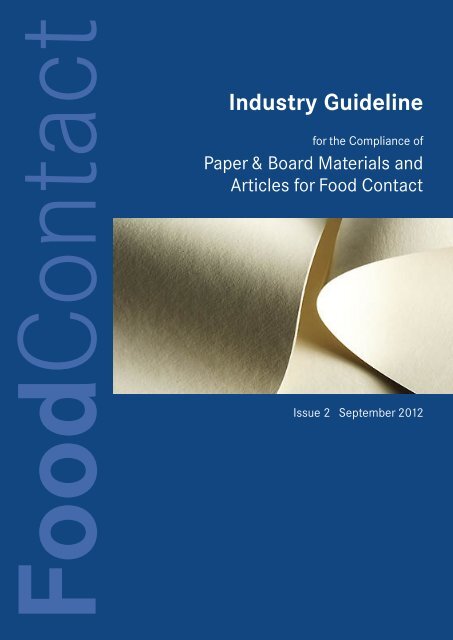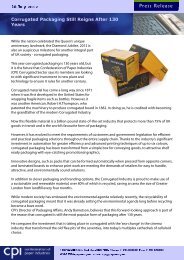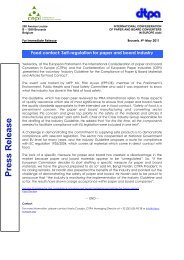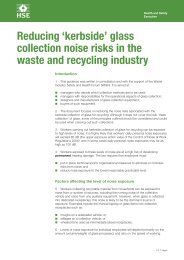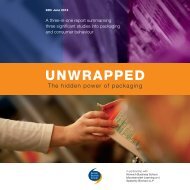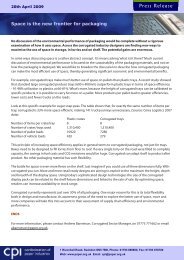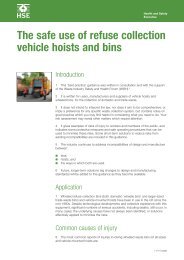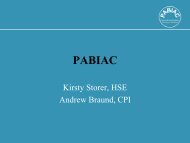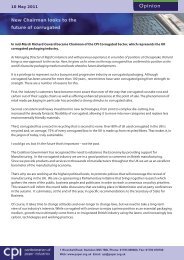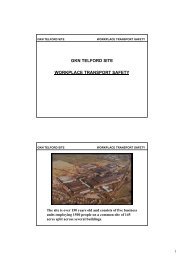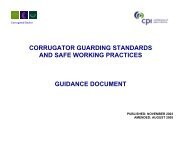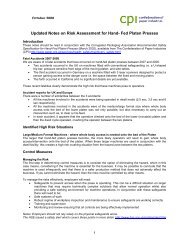Industry guideline for the Compliance of Paper & Board ... - cepi
Industry guideline for the Compliance of Paper & Board ... - cepi
Industry guideline for the Compliance of Paper & Board ... - cepi
You also want an ePaper? Increase the reach of your titles
YUMPU automatically turns print PDFs into web optimized ePapers that Google loves.
FoodContact<br />
<strong>Industry</strong> Guideline<br />
<strong>for</strong> <strong>the</strong> <strong>Compliance</strong> <strong>of</strong><br />
<strong>Paper</strong> & <strong>Board</strong> Materials and<br />
Articles <strong>for</strong> Food Contact<br />
Issue 2 September 2012
<strong>Industry</strong> Guideline<br />
<strong>for</strong> <strong>the</strong> <strong>Compliance</strong> <strong>of</strong><br />
<strong>Paper</strong> & <strong>Board</strong> Materials and<br />
Articles <strong>for</strong> Food Contact<br />
Issue 2 September 2012<br />
Developed by <strong>the</strong> European paper and board food packaging chain:<br />
CEFIC (suppliers <strong>of</strong> chemicals)<br />
CEPI (paper and board manufacturers)<br />
CITPA (paper and board converters)<br />
FPE (paper and board multi-layer manufacturers)
TABLE OF CONTENTS<br />
Foreword 1<br />
1. Introduction 4<br />
2. Core requirements 5<br />
3. Methodology 7<br />
4. Chemical testing 8<br />
5. Good manufacturing practice 11<br />
6. Best practice <strong>for</strong> treatments applied during converting operations 12<br />
7. Requirements <strong>for</strong> use within multi-layers 13<br />
8. Packaging layers not actually in food contact 15<br />
9. Traceability <strong>guideline</strong>s 16<br />
10. References 17<br />
Annexes 18<br />
Annex 1: List <strong>of</strong> substances 19<br />
Annex 2: Requirements <strong>for</strong> recovered paper 20<br />
Annex 3: Testing methods 22<br />
Annex 4: Declaration <strong>of</strong> compliance 24<br />
Annex 5: Future developments 25<br />
Figures 27<br />
Figure 1: <strong>Compliance</strong> Assessment Scheme <strong>for</strong> <strong>Paper</strong>making Operations 28<br />
Figure 2: <strong>Compliance</strong> Assessment Scheme <strong>for</strong> Converting Operations 29<br />
Figure 3: Elements <strong>of</strong> <strong>the</strong> Determination <strong>of</strong> <strong>Compliance</strong> 30
Foreword<br />
<strong>Paper</strong> and board has a long and successful history <strong>of</strong> safe use in <strong>the</strong> food industry in a wide<br />
range <strong>of</strong> applications. These include applications where intimate contact is involved, such as<br />
tea bags, baking papers, and filters, and direct contact packaging such as butter wrapping,<br />
sugar bags, and cartons <strong>for</strong> dry and frozen foods. In addition it has a very wide range <strong>of</strong><br />
uses in transport and distribution packaging.<br />
Although <strong>the</strong>re is a wide range <strong>of</strong> applications, <strong>the</strong> proportion <strong>of</strong> packaging made from<br />
uncoated and untreated paper and board and coming into direct contact with food bought<br />
by <strong>the</strong> end-consumer was estimated to be less than 3.5% (3.39% is <strong>the</strong> actual value quoted)<br />
<strong>of</strong> all direct contact food packaging in <strong>the</strong> EU-15 in 2000 (Ref. 1). Compared to o<strong>the</strong>r direct<br />
contact food packaging materials, <strong>for</strong> example plastics (estimated proportion around 70%),<br />
this estimate <strong>of</strong> 3.5%, less than 0.9 kg paper per person per year, is relatively low and thus<br />
consumer exposure is similarly low. In addition direct contact is primarily with dry food<br />
(approximately 50%) and with food that is to be peeled or washed (approximately 30%) so<br />
only <strong>the</strong> remaining 20% is <strong>for</strong> contact with moist and/or fatty food.<br />
Uncoated and untreated paper and board is not suitable to pack food with very high<br />
moisture content (<strong>for</strong> example liquid food or wet chilled products), since exposure to high<br />
moisture will cause disintegration <strong>of</strong> <strong>the</strong> material. For <strong>the</strong>se food types coated paper and<br />
board is commonly used, and in <strong>the</strong> great majority <strong>of</strong> applications direct food contact is<br />
with a plastic layer. The proportion <strong>of</strong> packaging made from coated paper and board was<br />
estimated to be 17% (equivalent to 4.4 kg per person per year) <strong>of</strong> all direct contact food<br />
packaging in <strong>the</strong> EU-15 in 2003 (Ref. 2). Between 70-80% <strong>of</strong> all coated paper and board that<br />
is in direct contact with food is liquid packaging board (used <strong>for</strong> instance in cartons <strong>for</strong> milk<br />
and beverages) and 75% <strong>of</strong> this has aluminium foil as a barrier layer in <strong>the</strong> laminate structure<br />
that will prevent migration from <strong>the</strong> paper and board. If liquid packaging board containing an<br />
aluminium layer is excluded, <strong>the</strong> proportion <strong>of</strong> coated paper and board packaging used <strong>for</strong><br />
food contact is 7.6% (equivalent to 1.93 kg per person per year).<br />
The paper and board sector has a long-standing commitment to <strong>the</strong> protection <strong>of</strong> human<br />
health and <strong>the</strong> interests <strong>of</strong> consumers through <strong>the</strong> provision <strong>of</strong> safe and functionally<br />
effective materials. The sector has cooperated over a long period <strong>of</strong> time with government,<br />
both at national and supra-national level, and with o<strong>the</strong>r regulators to ensure necessary<br />
measures <strong>for</strong> consumer protection. Over <strong>the</strong> past thirty years <strong>the</strong> basis <strong>for</strong> this measure at<br />
<strong>the</strong> European level has been Directives and most recently a Regulation concerning materials<br />
and articles intended to come into contact with food (Directives 76/893/EEC, 89/109/EEC<br />
and Regulation No (EC) 1935/2004).<br />
These Directives and <strong>the</strong> Regulation have all made provision <strong>for</strong> <strong>the</strong> adoption <strong>of</strong> specific<br />
directives or measures relating to particular groups <strong>of</strong> materials or articles. However so<br />
far no specific measure at <strong>the</strong> level <strong>of</strong> <strong>the</strong> European Union has been introduced <strong>for</strong> paper<br />
and board and, although national and o<strong>the</strong>r provisions exist, <strong>the</strong> European paper and board<br />
sector considers that it is now appropriate to publish this Guideline. As well as providing a<br />
methodology <strong>for</strong> establishing <strong>the</strong> suitability <strong>of</strong> paper and board <strong>for</strong> particular food contact<br />
applications, it is envisaged that this Guideline could <strong>for</strong>m <strong>the</strong> basis <strong>of</strong> a specific legislative<br />
measure in <strong>the</strong> future, a development that <strong>the</strong> paper-based packaging industry would welcome.<br />
1
This Guideline considers <strong>the</strong> specific nature <strong>of</strong> food contact paper and board with regard to<br />
<strong>the</strong> following aspects:<br />
1. <strong>Paper</strong> and board consists predominantly (around 99%) <strong>of</strong> cellulose fibres, naturally<br />
occurring minerals such as calcium carbonate, and natural polymers such as starch.<br />
Cellulose itself is a natural polymer based mainly on glucose units. The properties<br />
required <strong>of</strong> specific paper grades are obtained by adding chemicals that are in most<br />
cases used in amounts significantly less than 1% by weight <strong>of</strong> <strong>the</strong> paper and board. There<br />
are two categories <strong>of</strong> chemicals added:<br />
• Functional additives that are intended to stay in <strong>the</strong> paper and board in order to<br />
achieve a technical effect.<br />
• Process chemicals or processing aids that are used to improve <strong>the</strong> efficiency <strong>of</strong> <strong>the</strong><br />
papermaking process. These chemicals are not intended to stay in <strong>the</strong> paper and<br />
board and are usually washed out during <strong>the</strong> papermaking process.<br />
2. <strong>Paper</strong> and board <strong>for</strong> food contact is different from plastics where most legislative<br />
provisions have so far been concentrated. For instance:<br />
• It has low consumer exposure due to <strong>the</strong> low proportion <strong>of</strong> all direct contact food<br />
packaging, where <strong>the</strong> main application is contact with dry food.<br />
• It has a completely different manufacturing process compared to plastics.<br />
• Its predominant base polymer is cellulose whose monomer, ß-glucose, has no known<br />
adverse health issues.<br />
• Standard migration test methods used <strong>for</strong> plastics are not easily applicable or not<br />
appropriate <strong>for</strong> control.<br />
For <strong>the</strong>se reasons regulation and control <strong>of</strong> paper and board <strong>for</strong> food contact using <strong>the</strong><br />
“plastics” approach with control <strong>of</strong> numerous specific migration limits does not appear<br />
to be <strong>the</strong> most suitable. The already existing and widely used Recommendation XXXVI<br />
(plus parts I, 2 and 3) <strong>of</strong> <strong>the</strong> German BfR (Bundesinstitut für Risikobewertung, see Annex<br />
1) sets compositional limits and seems to be a more appropriate basis <strong>for</strong> regulation and<br />
control. This Recommendation is also referred to in o<strong>the</strong>r national requirements, e.g. <strong>the</strong><br />
French “Guide de Bonnes Pratiques”. The methodology in this Guideline is based on this BfR<br />
Recommendation, although substances which are <strong>the</strong> subject <strong>of</strong> o<strong>the</strong>r approvals may also<br />
be permitted (see Annex 1). Also introduced is a larger element <strong>of</strong> final product testing and<br />
specific requirements <strong>for</strong> <strong>the</strong> control <strong>of</strong> recovered paper.<br />
Issue 1 <strong>of</strong> this Guideline was <strong>the</strong> subject <strong>of</strong> an independent peer review,<br />
carried out by Pira International.<br />
The entire peer review can be downloaded at<br />
http://www.<strong>cepi</strong>.org/topics/foodcontact/publications/peerreview<br />
2
Preface to Issue 2, September 2012<br />
The <strong>Industry</strong> Guideline <strong>for</strong> <strong>the</strong> <strong>Compliance</strong> <strong>of</strong> <strong>Paper</strong> & <strong>Board</strong> Materials and Articles <strong>for</strong> Food<br />
Contact was first published by CEPI and CITPA two years ago.<br />
It has been well received by organizations and authorities at both European and national level,<br />
and has become a reference <strong>for</strong> <strong>the</strong> paper and board food packaging value chain. Its uptake has<br />
been wide and <strong>the</strong> greater part <strong>of</strong> <strong>the</strong> text is still considered to be current.<br />
The <strong>Industry</strong> Guideline was however conceived as a moving document, aligned with <strong>the</strong> whole<br />
food contact material sector, which is continuously evolving. Fairly frequent revisions were<br />
<strong>the</strong>re<strong>for</strong>e envisaged and this new version is considered timely.<br />
Stakeholders in <strong>the</strong> <strong>Industry</strong> Guideline were surveyed to assess <strong>the</strong> revision needs and from this<br />
survey a list <strong>of</strong> aspects to be revised was compiled. Key amongst <strong>the</strong>se aspects were:<br />
• <strong>the</strong> publication <strong>of</strong> <strong>the</strong> new CEPI GMP<br />
• <strong>the</strong> coming into <strong>for</strong>ce <strong>of</strong> Commission Regulation (EU) No 10/2011 <strong>for</strong> plastics<br />
• <strong>the</strong> update <strong>of</strong> <strong>the</strong> German BfR Recommendation XXXVI, and<br />
• <strong>the</strong> concerns over <strong>the</strong> presence <strong>of</strong> mineral oils hydrocarbons in food<br />
The revision has been made through <strong>the</strong> work <strong>of</strong> a Cross <strong>Industry</strong> Group, thus reflecting and<br />
continuing <strong>the</strong> original cross industry approach.<br />
The Cross <strong>Industry</strong> Group will continue its monitoring activity <strong>of</strong> <strong>the</strong> sector and <strong>the</strong> collection <strong>of</strong><br />
inputs to be taken into account <strong>for</strong> <strong>the</strong> next revision.<br />
The underlying aim is to make available to all stakeholders a relevant tool <strong>for</strong> demonstrating<br />
compliance <strong>of</strong> paper and board packaging and <strong>for</strong> <strong>the</strong> continuing supply <strong>of</strong> safe products to<br />
consumers.<br />
3
1<br />
1.1 Objective<br />
Introduction<br />
This document is aimed at manufacturers <strong>of</strong> paper and board materials and articles intended <strong>for</strong><br />
food contact and is designed to provide guidance <strong>for</strong> establishing compliance with Regulation<br />
(EC) No 1935/2004. Whilst it provides a methodology <strong>for</strong> <strong>the</strong> demonstration <strong>of</strong> <strong>the</strong> suitability <strong>of</strong><br />
materials and articles <strong>for</strong> a variety <strong>of</strong> food contact applications, in itself it has no legal <strong>for</strong>ce. Its<br />
use is voluntary and it should be noted that o<strong>the</strong>r compliance mechanisms exist which may be<br />
used separately or in conjunction with this Guideline.<br />
It is <strong>the</strong> intention that <strong>the</strong> contents <strong>of</strong> this document are not fixed and will be updated in<br />
accordance with evolving best practice and knowledge <strong>of</strong> food safety. See Annex 5 <strong>for</strong> details <strong>of</strong><br />
developments currently in progress within <strong>the</strong> paper and board industry.<br />
4<br />
1.2 Field <strong>of</strong> Application<br />
<strong>Paper</strong> and board materials and articles are manufactured from cellulose-based natural fibres both<br />
bleached and unbleached, from primary and recycled sources. In addition paper and board may<br />
contain functional additives and syn<strong>the</strong>tic fibres and also o<strong>the</strong>r treatment agents and polymeric<br />
binders <strong>for</strong> organic and inorganic pigments.<br />
This Guideline applies to materials and articles constituted <strong>of</strong> paper and board (excluding nonwovens<br />
as defined by ISO 9092) which may comprise one or more layers <strong>of</strong> fibre and which in<br />
<strong>the</strong>ir finished state:<br />
• are intended to be brought into contact with food, or<br />
• are already in contact with food and were intended <strong>for</strong> that purpose, or<br />
• can reasonably be expected to be brought into contact with food or to transfer <strong>the</strong>ir<br />
constituents to food under normal or <strong>for</strong>eseeable conditions <strong>of</strong> use.<br />
The two principal operations in <strong>the</strong> manufacture <strong>of</strong> paper and board materials and articles <strong>for</strong><br />
food contact are normally papermaking and conversion. Most <strong>of</strong> <strong>the</strong> specific requirements given<br />
in this Guideline will apply at <strong>the</strong> papermaking stage and will be applicable to paper and board at<br />
<strong>the</strong> completion <strong>of</strong> that operation. Some requirements are relevant to <strong>the</strong> converting operation.<br />
<strong>Paper</strong> and board includes mineral coated papers, and <strong>the</strong> components including polymeric<br />
binders in <strong>the</strong> coating <strong>for</strong>mula are covered by <strong>the</strong> requirements <strong>of</strong> this Guideline.<br />
This Guideline may also be applied to paper and board as it is used in o<strong>the</strong>r coated and laminated<br />
materials, including combinations with plastics, aluminium, and waxes. Specific sections <strong>of</strong> this<br />
Guideline deal with multi-material multi-layer materials involving combinations <strong>of</strong> paper and<br />
board and plastics, filtering and baking applications, and packaging not actually in food contact.<br />
Tissue paper, kitchen towels and napkins are covered by specific <strong>guideline</strong>s (Ref. 3) and<br />
are excluded from <strong>the</strong> scope <strong>of</strong> this Guideline.<br />
In providing requirements and a methodology to establish compliance with Regulation<br />
1935/2004, it is expected that this Guideline would become widely used by companies operating<br />
in markets potentially covering all member states <strong>of</strong> <strong>the</strong> European Union. Certain European<br />
countries have specific national legislation covering food contact applications which will take<br />
precedence over this Guideline and compliance with that legislation may be required.
2<br />
CORE<br />
REQUIREMENTS<br />
2.1 Regulation (EC) No 1935/2004<br />
In accordance with Article 3 <strong>of</strong> Regulation 1935/2004:<br />
“Materials and articles, made <strong>of</strong> paper and board, shall be manufactured in compliance with<br />
good manufacturing practice so that, under normal or <strong>for</strong>eseeable conditions <strong>of</strong> use, <strong>the</strong>y<br />
do not transfer <strong>the</strong>ir constituents to food in quantities which could:<br />
• endanger human health, or<br />
• bring about an unacceptable change in <strong>the</strong> composition <strong>of</strong> <strong>the</strong> food, or<br />
• bring about a deterioration in <strong>the</strong> organoleptic characteristics <strong>of</strong> <strong>the</strong> food.”<br />
This is <strong>the</strong> core EU legislative requirement <strong>for</strong> all materials and articles intended <strong>for</strong> food contact<br />
and which has been essentially unchanged since 1976. Fur<strong>the</strong>r sections <strong>of</strong> this Guideline deal with<br />
specific test and per<strong>for</strong>mance requirements and <strong>the</strong> methodology <strong>for</strong> <strong>the</strong>ir application, that provide<br />
<strong>the</strong> practical demonstration <strong>of</strong> con<strong>for</strong>mance with this legislative requirement.<br />
In particular:<br />
• Clause 5 <strong>of</strong> this Guideline gives <strong>the</strong> requirements which shall be followed to provide<br />
<strong>the</strong> assurance <strong>of</strong> good manufacturing practice. <strong>Paper</strong> and board shall be <strong>of</strong> a suitable<br />
microbiological quality taking into consideration <strong>the</strong> potential end-use applications and<br />
control <strong>of</strong> this aspect is a part <strong>of</strong> <strong>the</strong> GMP requirements in Clause 5.<br />
• Annex 1 <strong>of</strong> this Guideline lists <strong>the</strong> substances permitted <strong>for</strong> use in <strong>the</strong> manufacture <strong>of</strong> paper<br />
and board intended <strong>for</strong> food contact and conditions <strong>for</strong> <strong>the</strong>ir use. The restrictions provided in<br />
Annex 1 shall apply.<br />
• Recovered paper is used in <strong>the</strong> manufacture <strong>of</strong> many grades <strong>of</strong> food contact paper and board.<br />
This Guideline has in place a number <strong>of</strong> requirements and ensures that <strong>the</strong>re is a structured<br />
and controlled framework <strong>for</strong> operations involving <strong>the</strong> use <strong>of</strong> recovered paper. Annex 2 lists<br />
<strong>the</strong> details <strong>of</strong> <strong>the</strong>se controls and gives <strong>the</strong> requirements which shall apply.<br />
5
2.2 Demonstration <strong>of</strong> <strong>Compliance</strong><br />
In order to provide evidence <strong>of</strong> compliance with this Guideline and Regulation 1935/2004, two<br />
mechanisms shall be in place. Firstly, a <strong>for</strong>mal declaration <strong>of</strong> compliance shall be prepared<br />
<strong>for</strong> each grade or type <strong>of</strong> food contact material or article. This shall be issued and available<br />
<strong>for</strong> immediate inspection both by en<strong>for</strong>cement authorities and customers. Annex 4 gives <strong>the</strong><br />
requirements <strong>for</strong> <strong>the</strong> content <strong>of</strong> <strong>the</strong> declaration <strong>of</strong> compliance.<br />
Second, business operators shall maintain appropriate documentation and records which serve<br />
as evidence <strong>of</strong> <strong>the</strong> statements made in <strong>the</strong> declaration <strong>of</strong> compliance. It is expected that <strong>the</strong>se<br />
latter records will consist largely <strong>of</strong> a continuously updated database <strong>of</strong> internal in<strong>for</strong>mation<br />
and, as such, cannot be made available in a single dossier <strong>for</strong> immediate inspection. Business<br />
operators shall however produce on demand and within a reasonable timeframe <strong>for</strong> <strong>the</strong><br />
competent authorities adequate summaries <strong>of</strong> this in<strong>for</strong>mation to demonstrate such compliance.<br />
This documentation shall include <strong>the</strong> conditions and results <strong>of</strong> testing, calculations, o<strong>the</strong>r<br />
analysis, and evidence <strong>of</strong> <strong>the</strong> safety or reasoning demonstrating compliance.<br />
The documentation shall be made available to <strong>the</strong> competent authorities on demand. The<br />
operators may indicate which in<strong>for</strong>mation is to be treated as confidential on <strong>the</strong> grounds that its<br />
disclosure might significantly harm <strong>the</strong>ir competitive position.<br />
The requirements <strong>of</strong> Article 15 <strong>of</strong> Regulation 1935/2004 with regard to labelling shall be applied.<br />
It should be noted that paragraph 2 <strong>of</strong> Article 15 states that labelling shall not be obligatory <strong>for</strong><br />
articles which, because <strong>of</strong> <strong>the</strong>ir characteristics, are clearly intended to come into contact with food.<br />
6
3<br />
Methodology<br />
methodology<br />
3.1 Assessing <strong>Compliance</strong><br />
Figure 1 provides a schematic representation <strong>of</strong> <strong>the</strong> method <strong>for</strong> assessing compliance <strong>for</strong><br />
papermaking operations, working through <strong>the</strong> processes in a logical sequence.<br />
It covers:<br />
1. control <strong>of</strong> raw materials as required by Annexes 1 & 2<br />
2. control <strong>of</strong> <strong>the</strong> process as required by Clause 5 (GMP)<br />
3. product requirements covered by:<br />
• chemical testing required by Clause 4<br />
• traceability as required by Clause 9<br />
In fulfilling <strong>the</strong> sequence described in Figure 1 <strong>the</strong> assessments <strong>for</strong> <strong>the</strong> papermaking operations<br />
are complete. The subsequent stage covers conversion operations and <strong>the</strong> controls required <strong>for</strong><br />
<strong>the</strong>se operations are summarised in Figure 2.<br />
3.2 General Principles relating to Frequency <strong>of</strong> Testing<br />
The purpose <strong>of</strong> <strong>the</strong> restrictions and <strong>the</strong> relevant chemical tests, detailed in this Guideline,<br />
is to ensure that <strong>the</strong> material or article is fit <strong>for</strong> its intended purpose. Testing shall <strong>the</strong>re<strong>for</strong>e<br />
be per<strong>for</strong>med at a frequency which relates to <strong>the</strong> likelihood <strong>of</strong> a particular restriction being<br />
exceeded 1 . In <strong>the</strong> special case where conclusive evidence demonstrates that a substance could<br />
never exceed its restriction in <strong>the</strong> material or article <strong>the</strong>n testing is not required 2 .<br />
3.3 Risk Assessment Frequency<br />
A documented risk assessment shall be per<strong>for</strong>med when significant changes have taken place in<br />
<strong>the</strong> equipment or process used to manufacture <strong>the</strong> material or article or in <strong>the</strong> supply <strong>of</strong> its raw<br />
materials. The purpose <strong>of</strong> this would be to establish if product characteristics were likely to be<br />
altered sufficiently to necessitate short or long-term changes in <strong>the</strong> testing regime.<br />
7<br />
1. Guidance on this matter is given in <strong>the</strong> CEPI Good Manufacturing Practice <strong>for</strong> papermaking published in 2010.<br />
2. This exception does not replace <strong>the</strong> responsibility <strong>of</strong> <strong>the</strong> operator to ensure compliance, at all times, with Regulation 1935/2004
4<br />
CHEMICAL<br />
Chemical TESTING Testing<br />
The restriction limits given in Table 1 shall apply to all paper and board covered by this Guideline.<br />
As described in <strong>the</strong> following paragraphs and Note 3 to Table 1, testing requirements will depend<br />
on <strong>the</strong> paper and board used and <strong>the</strong> type <strong>of</strong> contact.<br />
The substances identified in <strong>the</strong> “Remark” column <strong>of</strong> Table 1 with * are generally found only in<br />
recovered paper and board and will not need, in normal circumstances, to be subject to tests<br />
<strong>for</strong> paper and board manufactured solely from virgin fibre. See General Principles relating to<br />
Frequency <strong>of</strong> Testing in Clause 3 <strong>for</strong> fur<strong>the</strong>r guidance in cases where testing is not required.<br />
The substances identified in <strong>the</strong> “Remark” column <strong>of</strong> Table 1 with # will need to be subject to<br />
tests only if, in normal circumstances, <strong>the</strong> end use <strong>of</strong> <strong>the</strong> paper and board is known to be <strong>for</strong><br />
contact with moist and/or fatty food 3 .<br />
Table 1 – Purity Requirements 4567<br />
Substance<br />
Limit in food<br />
sml (mg/kg food)<br />
Tested in<br />
paper & board<br />
Limit<br />
remark<br />
Cadmium - 0.5 mg/kg #<br />
Lead - 3.0 mg/kg #<br />
Mercury - 0.3 mg/kg #<br />
Pentachlorophenol - 0.15 mg/kg<br />
Antimicrobial<br />
Substances<br />
4,4’-bis (dimethylamino)-<br />
benzophenone (Michler’s<br />
ketone)<br />
4,4’-bis (diethylamino)<br />
benzophenone (DEAB)<br />
-<br />
0.01 mg/kg<br />
(non-detectable)<br />
0.01 mg/kg<br />
(non-detectable)<br />
Azo colourants 4 -<br />
No release <strong>of</strong> substances<br />
in quantities which have<br />
an antimicrobial effect.<br />
0.0016 mg/dm 2 #<br />
*<br />
0.0016 mg/dm 2 #<br />
*<br />
0.1 mg/kg<br />
as aromatic amine 5 #<br />
(non-detectable)<br />
Dyes and colourants 6 - no bleeding #<br />
Fluorescent Whitening Agents<br />
(FWAs) 6 - no bleeding #<br />
Polycyclic Aromatic<br />
Hydrocarbons (PAHs)<br />
0.01 mg/kg<br />
(non-detectable)<br />
0.0016 mg/dm 2 7 *<br />
Di-n-butylphthalate (DBP) 0.3 mg/kg 0.05 mg/dm 2 *<br />
Diethylhexylphthalate (DEHP) 1.5 mg/kg 0.25 mg/dm 2 *<br />
8<br />
3. This is from <strong>the</strong> BfR Recommendation (see Annex 1) and this exception does not replace <strong>the</strong> responsibility <strong>of</strong> <strong>the</strong> operator to ensure<br />
compliance, at all times, with Regulation 1935/2004, particularly Article 3.<br />
4. Testing is only required <strong>for</strong> virgin fibre based papers if azo colourants are added to <strong>the</strong> paper<br />
5. Sum <strong>of</strong> listed amines. Regulation (EC) No 1907/2006 Annex XVII Appendix 8 http://eur-lex.europa.eu/LexUriServ/LexUriServ.do?uri=<br />
OJ:L:2006:396:0001:0849:EN:PDF<br />
6. Testing is only required <strong>for</strong> virgin fibre based papers if dyes/colourants/optical brighteners are added to <strong>the</strong> paper<br />
7. Sum <strong>of</strong> listed PAH’s . A method <strong>for</strong> PAH measurement is in preparation in CEN/TC172/WG3.<br />
4<br />
5<br />
6<br />
7
5<br />
Substance<br />
Limit in food<br />
sml (mg/kg food)<br />
Tested in<br />
paper & board<br />
Limit<br />
remark<br />
Diisobutylphthalate (DiBP) 0.3 mg/kg 0.05 mg/dm 2 *<br />
SUM DBP + DiBP 0.3 mg/kg 0.05 mg/dm 2 *<br />
Benzylbutylphthalate (BBP) 30 mg/kg 5 mg/dm 2 *<br />
Diisononylphthalate (DINP) 9 mg/kg 1.5 mg/dm 2 *<br />
Diisodecylphthalate (DIDP) 9 mg/kg 1.5 mg/dm 2 *<br />
Benzophenone 0.6 mg/kg 0.1 mg/dm 2 *<br />
SUM benzophenone+<br />
hydroxy-benzophenone+<br />
4-methylbenzophenone<br />
0.6 mg/kg 0.1 mg/dm 2<br />
Diisopropylnapthalenes (DIPN) -<br />
As low as technically<br />
possible *<br />
Bisphenol A 0.6 mg/kg 0.1 mg/dm 2 #<br />
*<br />
Note 1: Testing <strong>for</strong> compliance with <strong>the</strong> limits in Table 1 should be carried out according to <strong>the</strong> testing<br />
methods and principles set out in Annex 3. Figure 3 provides a schematic representation <strong>of</strong> some elements<br />
<strong>of</strong> <strong>the</strong> determination <strong>of</strong> compliance.<br />
Note 2: The limits quoted in Table 1 are from published sources, principally <strong>the</strong> BfR Recommendation<br />
XXXVI (Annex 1)and <strong>the</strong> Council <strong>of</strong> Europe Resolution ResAP (2002)1 and its Technical Document No. 3 (Ref.<br />
4). The limits <strong>for</strong> phthalates are taken from Directive 2007/19/EC dated March 30, 2007 (DBP, DEHP, BBP,<br />
DINP, DIDP) and <strong>for</strong> DiBP from BfR Recommendation XXXVI (see Annex 1).<br />
Note 3: There is a wide range <strong>of</strong> end use applications <strong>for</strong> paper and board food packaging which vary greatly<br />
in <strong>the</strong>ir potential <strong>for</strong> substances to migrate to food. Thus testing <strong>for</strong> compliance with <strong>the</strong> limits in Table 1<br />
need not be per<strong>for</strong>med if it can be shown that <strong>the</strong> requirements <strong>of</strong> Regulation 1935/2004 are met. This<br />
requires that, under normal and <strong>for</strong>eseeable conditions <strong>of</strong> use, materials and articles do not transfer <strong>the</strong>ir<br />
constituents to food in quantities which could:<br />
a) endanger human health, or<br />
b) bring about an unacceptable change in <strong>the</strong> composition <strong>of</strong> food, or<br />
c) bring about a deterioration in <strong>the</strong> organoleptic characteristics <strong>of</strong> <strong>the</strong> food.<br />
Where testing is needed to demonstrate compliance with <strong>the</strong> requirements <strong>of</strong> Table 1 and Annex 1, <strong>the</strong><br />
general principles in Clause 3 and <strong>the</strong> CEPI GMP document shall apply.<br />
Note 4: The reason <strong>for</strong> some limits being quoted in units <strong>of</strong> weight/weight and some in weight/area is <strong>the</strong><br />
different sources <strong>for</strong> <strong>the</strong> limits. The limits expressed as mg/dm 2 are derived from specific migration limits<br />
(SMLs) and are expressed as maximum permitted residual amount (QMA) <strong>of</strong> a substance in paper and board<br />
assuming total transfer.<br />
In practice, an analytical measurement will give a weight/weight result and a conversion to weight/<br />
area considering <strong>the</strong> actual grammage <strong>of</strong> <strong>the</strong> paper and board will be required <strong>for</strong> comparison with limits<br />
expressed as weight/area. (See Note, Figure 3)<br />
Note 5: If it is assumed that complete migration <strong>of</strong> a substance occurs from <strong>the</strong> paper and board to <strong>the</strong><br />
food it is possible convert limits in food (SMLs) to a total quantity <strong>of</strong> <strong>the</strong> substance in paper and board. The<br />
“standard” packaging /food ratio in EU risk assessments <strong>of</strong> migration is 6 dm 2 packaging material in direct<br />
contact with 1 kg food. Using this “standard” ratio <strong>the</strong> SML should be multiplied by 0.167 (or divided by 6) to<br />
obtain a maximum permitted content in 1 dm 2 <strong>of</strong> paper and board (QMA).<br />
9
5<br />
If<br />
<strong>the</strong> packaging to food ratio differs from <strong>the</strong> standard ratio <strong>of</strong> 0.167 and <strong>the</strong> value <strong>of</strong> <strong>the</strong> ratio is known, it is<br />
permitted to use this value to obtain <strong>the</strong> QMA.<br />
Note 6: Studies on mineral oil hydrocarbons found in foodstuffs have raised questions about consumer<br />
safety. According to <strong>the</strong>se studies, traces <strong>of</strong> mineral oils are thought to migrate to food from inks present<br />
both on <strong>the</strong> printed surface <strong>of</strong> packaging and in recycled fibre used in <strong>the</strong> production <strong>of</strong> packaging papers.<br />
The European Food Safety Authority (EFSA) published in June 2012 a scientific opinion on <strong>the</strong> topic; see<br />
http://www.efsa.europa.eu/en/efsajournal/pub/2704.htm<br />
In <strong>the</strong> absence <strong>of</strong> a validated test method and with <strong>the</strong> uncertainty continuing to surround <strong>the</strong> hazard posed<br />
by mineral oil hydrocarbons, it is not currently possible to include limits values in Table 1. The paper and<br />
board sector has however taken a number <strong>of</strong> measures to limit <strong>the</strong> presence <strong>of</strong> mineral oils hydrocarbons in<br />
<strong>the</strong> food contact packaging including making commitments to use only mineral oil-free inks <strong>for</strong> printing this<br />
packaging. It should also be noted that <strong>the</strong> potential migration <strong>of</strong> mineral oil hydrocarbons from packaging<br />
into food can be limited by reducing as far as possible storage time and temperature <strong>of</strong> <strong>the</strong> food after packing.<br />
10
5<br />
Good Manufacturing Practice<br />
Good Manufacturing Practice (GMP), in relation to food contact materials is defined as: “those<br />
aspects <strong>of</strong> quality assurance which ensure that materials and articles are consistently produced<br />
and controlled to ensure con<strong>for</strong>mity with <strong>the</strong> rules applicable to <strong>the</strong>m and with <strong>the</strong> quality standards<br />
appropriate to <strong>the</strong>ir intended use by not endangering human health or causing an unacceptable<br />
change in <strong>the</strong> composition <strong>of</strong> <strong>the</strong> food or causing a deterioration in <strong>the</strong> organoleptic characteristics<br />
<strong>the</strong>re<strong>of</strong>”<br />
GMP shall apply to all aspects <strong>of</strong> <strong>the</strong> processes involved, starting from <strong>the</strong> selection and usage<br />
<strong>of</strong> chemicals, wood-pulp and recovered paper, through <strong>the</strong> operation <strong>of</strong> paper machines and<br />
finishing with converting operations and transport. It is recommended that GMP is implemented<br />
through <strong>for</strong>mal management systems. Where this is not <strong>the</strong> case it shall be demonstrated that <strong>the</strong><br />
arrangements provide <strong>the</strong> same level <strong>of</strong> assurance as a <strong>for</strong>mal management system.<br />
Note: Regulation (EC) No 2023/2006 on GMP contains a requirement <strong>for</strong> a <strong>for</strong>mal quality assurance system.<br />
Con<strong>for</strong>mance with <strong>the</strong> requirements <strong>of</strong> <strong>the</strong> ISO 9000 series will cover much <strong>of</strong> what is required to<br />
fulfil GMP requirements which will include con<strong>for</strong>mance to specification and use <strong>of</strong> appropriate<br />
substances and preparations. The balance could be provided by con<strong>for</strong>mance with <strong>for</strong>mal hygiene<br />
management systems (which include aspects such as control <strong>of</strong> contamination). Given below are<br />
examples <strong>of</strong> schemes which include some or all <strong>of</strong> <strong>the</strong> above aspects.<br />
For papermaking <strong>the</strong> CEPI Good Manufacturing Practice Guidance, published in September<br />
2010, is a completely rewritten document <strong>for</strong> manufacturers <strong>of</strong> paper and board <strong>for</strong> food contact<br />
applications. It replaces <strong>the</strong> version published in 2002 and is focused on risk assessment, ensuring<br />
appropriate controls throughout <strong>the</strong> process and integrating quality aspects relevant to food<br />
packaging into existing quality management systems in paper mills.<br />
Aspects <strong>of</strong> <strong>the</strong> special safety controls required <strong>for</strong> <strong>the</strong> use <strong>of</strong> recovered paper in paper and board<br />
<strong>for</strong> food contact will be included in <strong>the</strong> management systems set up under <strong>the</strong> GMP requirements.<br />
These controls relating to GMP are included in Annex 2.<br />
<strong>Paper</strong>making operations<br />
• Good Manufacturing Practice <strong>for</strong> <strong>the</strong> Manufacture <strong>of</strong> <strong>Paper</strong> and <strong>Board</strong> <strong>for</strong> Food Contact.<br />
CEPI September 2010 (referred to as <strong>the</strong> “CEPI GMP” Ref. 5).<br />
Note 1: This GMP includes requirements covered by <strong>the</strong> CEPI Guidelines <strong>for</strong> Responsible Sourcing and Supply<br />
<strong>of</strong> Recovered <strong>Paper</strong> (Ref. 6)<br />
Note 2: The relevant standards listed <strong>for</strong> converting operations may be applied to papermaking operations.<br />
This may be on <strong>the</strong> initiative <strong>of</strong> <strong>the</strong> manufacturer or as a result <strong>of</strong> a customer request. Such standards<br />
will normally be applied in mills manufacturing grades <strong>of</strong> paper and board <strong>for</strong> <strong>the</strong> most critical food<br />
contact applications.<br />
Converting operations<br />
• CEN Standard EN 15593:2008<br />
• o<strong>the</strong>r appropriate standards include <strong>the</strong> FEFCO/ESBO GMP, <strong>the</strong> ECMA GMP, <strong>the</strong> FPE/CITPA<br />
GMP, PAS 223 in conjunction with ISO 22000 and <strong>the</strong> BRC/IOP Standard. (Ref. 7, 8, 9, 10,<br />
11, 12).<br />
11
6<br />
Best practice <strong>for</strong> treatments applied during<br />
converting operations<br />
Best practices <strong>for</strong> converting operations should result from a hazard analysis and a risk<br />
assessment. For packaging, <strong>the</strong> risk assessment shall be extended to <strong>the</strong> whole packaging<br />
system.<br />
Inks, varnishes and adhesives used <strong>for</strong> printing and converting should be selected to ensure <strong>the</strong><br />
lowest possible levels <strong>of</strong> migration into food by following <strong>the</strong> requirements <strong>of</strong> <strong>the</strong> Regulation<br />
2023/2006. This process should be facilitated by consultation with <strong>the</strong> suppliers <strong>of</strong> those<br />
materials and <strong>the</strong>ir guidance on <strong>the</strong> use <strong>of</strong> low migration and low odour products. Reference<br />
should be made where appropriate to <strong>the</strong> EuPIA Guideline (Ref. 13).<br />
The following two specific recommendations are made:<br />
- UV cured inks: in view <strong>of</strong> <strong>the</strong> history <strong>of</strong> <strong>the</strong> use <strong>of</strong> <strong>the</strong>se products and <strong>the</strong> photoinitiators<br />
that <strong>the</strong>y contain, it is recommended that <strong>the</strong>y are not used in any packaging application.<br />
However, it is known that certain manufacturers have begun to produce new and safer<br />
photoinitiators and operators could use such products following assurances from those<br />
manufacturers over <strong>the</strong>ir suitability <strong>for</strong> food contact in <strong>the</strong> application envisaged.<br />
Inks containing mineral oils: in view <strong>of</strong> <strong>the</strong> finding <strong>of</strong> <strong>the</strong> migration <strong>of</strong> mineral oils in food (see<br />
Clause 4 Note 6), it is recommended that printing inks containing mineral oils are not used <strong>for</strong><br />
printing paper and board packaging. CITPA members have entered into a self-commitment,<br />
toge<strong>the</strong>r with CEPI members, to phase out <strong>the</strong> use <strong>of</strong> mineral oils.<br />
See www.<strong>cepi</strong>.org/topics/foodcontact/pressrelease/mineraloils<br />
See also Annex 2 (Requirements <strong>for</strong> recovered paper) Section 3 and Figure 2.<br />
12
7<br />
Requirements<br />
<strong>for</strong> use within multi-layers<br />
7.1 General<br />
This clause provides <strong>the</strong> requirements <strong>for</strong> materials and articles intended <strong>for</strong> food contact and which<br />
are composed <strong>of</strong> two or more layers <strong>of</strong> different types <strong>of</strong> materials (termed multi-material multilayers<br />
(MMML)) which are intentionally bound toge<strong>the</strong>r and where one <strong>of</strong> <strong>the</strong> layers is paper. The<br />
commonly used materials <strong>for</strong> such multi-layer constructions in combination with paper and board<br />
are various types <strong>of</strong> plastic film and aluminium foil.<br />
In considering multi-material multi-layers in which paper or board is present, two cases need to be<br />
distinguished:<br />
1. MMML in which paper or board is present toge<strong>the</strong>r with one or more non-plastic layer(s)<br />
such as aluminium foil, or o<strong>the</strong>rs, but no plastic layer;<br />
2. MMML in which paper and board is present toge<strong>the</strong>r with at least one plastic layer, and<br />
optionally o<strong>the</strong>r layers.<br />
A plastic layer laminated or extrusion-coated on to a paper web is considered a plastic film in <strong>the</strong><br />
context <strong>of</strong> this clause. It has to be noted that such products are <strong>of</strong>ten referred to as “coated paper”<br />
within <strong>the</strong> industry although strictly a distinction should be made between <strong>the</strong> plastic coated papers<br />
covered by this clause and papers coated with minerals such as calcium carbonate which are outside<br />
<strong>the</strong> scope <strong>of</strong> this clause and are covered by Clause 2 and Annex 1 <strong>of</strong> this Guideline. O<strong>the</strong>r non-plastic<br />
coatings, as well as printing inks, are not plastic layers in <strong>the</strong> context <strong>of</strong> this clause.<br />
Constructions involving packaging applications, such as “bag-in-box” packaging, where <strong>the</strong> material<br />
layers are not intentionally bound toge<strong>the</strong>r are not MMML.<br />
MMML which correspond to case 1 defined above are required to comply with <strong>the</strong> Framework<br />
Regulation 1935/2004 and <strong>the</strong> GMP Regulation 2023/2006. There is no specific Community<br />
legislation laying down detailed requirements <strong>for</strong> <strong>the</strong>se MMML.<br />
MMML which correspond to case 2 defined above, are also required to comply with <strong>the</strong> Framework<br />
Regulation 1935/2004 and <strong>the</strong> GMP Regulation 2023/2006, but additionally <strong>the</strong> plastic layer(s) are<br />
required to meet specific requirements imposed by Regulation 10/2011<br />
Note: Regulation 10/2011 does not regulate <strong>the</strong> non-plastic layers or <strong>the</strong> finished MMML, o<strong>the</strong>r than<br />
<strong>the</strong> limit <strong>for</strong> vinyl chloride monomer.<br />
13
7.2 Requirements<br />
7.2.1 Requirements <strong>for</strong> paper and board when it is in direct contact with <strong>the</strong> food<br />
<strong>Paper</strong> and board shall comply with this Guideline as if it was used by itself.<br />
7.2.2 Requirements <strong>for</strong> paper and board not in direct contact with <strong>the</strong> food<br />
The paper or board shall comply with this Guideline unless it is verified that a functional barrier<br />
layer is present between <strong>the</strong> food and <strong>the</strong> paper or board layer.<br />
Note 1: “functional barrier” is defined in Regulation 10/2011, Article 3 (15).<br />
Note 2: <strong>the</strong> influence <strong>of</strong> “set-<strong>of</strong>f” needs to be considered when evaluating <strong>the</strong> effectiveness <strong>of</strong> a<br />
functional barrier.<br />
7.2.3 Requirements <strong>for</strong> materials o<strong>the</strong>r than paper and board<br />
Materials o<strong>the</strong>r than paper and board used in multi-layer constructions shall con<strong>for</strong>m to <strong>the</strong><br />
relevant European or national legislation and/or <strong>guideline</strong>s applicable to <strong>the</strong>m.<br />
In <strong>the</strong> case <strong>of</strong> plastics, Regulation 10/2011 requires that <strong>the</strong> plastic layer(s) in a MMML should<br />
fulfil <strong>the</strong> compositional requirements (Art. 14.1) <strong>of</strong> <strong>the</strong> Regulation but <strong>the</strong> overall migration limit<br />
(OML) and specific migration limit (SML) requirements set out <strong>for</strong> materials exclusively made<br />
from plastics do not apply to plastic layers in a MMML or to <strong>the</strong> MMML as a whole. (Art. 14.4).<br />
Note: In order to demonstrate compliance with Regulation 1935/2004, <strong>the</strong> requirements on<br />
inertness and toxicological safety should be considered. These aspects are outside <strong>the</strong> scope <strong>of</strong><br />
this Guideline but it should be recognised that OML tests conventionally used <strong>for</strong> plastics do not<br />
work particularly well when a paper and board layer is involved.<br />
7.2.4 Requirements <strong>for</strong> plastic layers not in direct contact with <strong>the</strong> food<br />
These plastic layers should fulfil <strong>the</strong> compositional requirements <strong>of</strong> Regulation 10/2011 (Art. 14.1)<br />
unless it is verified that a functional barrier layer is present between <strong>the</strong> plastic layer and <strong>the</strong> food<br />
(Art. 14.2-14.3) 8 .<br />
7.2.5 Requirements <strong>for</strong> <strong>the</strong> finished multi-material multi-layer<br />
There are no explicit requirements on compliance testing <strong>for</strong> <strong>the</strong> finished MMML.<br />
Note: <strong>the</strong> occasion may arise that en<strong>for</strong>cement authorities analysing <strong>the</strong> food, or third party<br />
laboratories testing with simulants on behalf <strong>of</strong> end customers, find a substance migrating which<br />
has an SML in <strong>the</strong> plastics legislation. If <strong>the</strong> food contact layer is a plastic, this will raise compliance<br />
questions. To be better prepared <strong>for</strong> such cases, <strong>the</strong> operator is recommended to collect<br />
in<strong>for</strong>mation on substances authorised with restrictions present in any layer <strong>of</strong> <strong>the</strong> MMML.<br />
If <strong>the</strong> migrant originates from a paper or board layer and not from <strong>the</strong> food contact plastic, <strong>the</strong><br />
migration level may be corrected to take into account that <strong>the</strong> usage <strong>of</strong> paper/plastic MMML is less<br />
than <strong>the</strong> 6 dm² per person per day which is assumed <strong>for</strong> plastics.<br />
14<br />
8. For background in<strong>for</strong>mation see: Packaging materials:9. Multi-layer packaging <strong>for</strong> food and beverages, ILSI (2011)
8<br />
packaging LAYERS NOT ACTUALLY IN FOOD<br />
CONTACT<br />
Regulation 1935/2004 applies to materials and articles in contact with food, or that “can<br />
reasonably be expected to be brought into contact with or to transfer <strong>the</strong>ir constituents to food<br />
under normal or <strong>for</strong>eseeable conditions <strong>of</strong> use” (Article 1 (c)). This means that <strong>the</strong> Regulation<br />
does not just apply to <strong>the</strong> packaging layer actually in contact with <strong>the</strong> food. There<strong>for</strong>e a<br />
judgement needs to be made on whe<strong>the</strong>r or not <strong>the</strong> layers <strong>of</strong> packaging which are not actually<br />
in contact with <strong>the</strong> food still fall within <strong>the</strong> scope <strong>of</strong> <strong>the</strong> Regulation because <strong>of</strong> a transfer <strong>of</strong><br />
constituents.<br />
In many applications <strong>the</strong> packaging actually in contact with <strong>the</strong> food very obviously provides a<br />
complete barrier (examples <strong>of</strong> such packaging include glass bottles and metal cans) and <strong>the</strong><br />
paper and board packaging used in subsequent layers does not fall within <strong>the</strong> scope <strong>of</strong> this<br />
Regulation<br />
In o<strong>the</strong>r applications, <strong>for</strong> instance when <strong>the</strong> packaging actually in contact with <strong>the</strong> food is a layer<br />
which may allow transfer or <strong>the</strong> food being packed is particularly susceptible to organoleptic<br />
changes, <strong>the</strong> Regulation may apply. The packaging manufacturer is not normally in a position to<br />
assess <strong>the</strong> interactions which may occur given <strong>the</strong> diversity <strong>of</strong> food packed in similar containers<br />
and <strong>the</strong> complexity <strong>of</strong> <strong>the</strong> interactions particularly relating to taint and odour. Thus, while <strong>the</strong><br />
manufacturer <strong>of</strong> a specific part <strong>of</strong> <strong>the</strong> packaging system will be in a position to give assurances on<br />
<strong>the</strong> constituents <strong>of</strong> <strong>the</strong> that part <strong>of</strong> <strong>the</strong> packaging system, <strong>the</strong> user <strong>of</strong> <strong>the</strong> packaging, (commonly<br />
<strong>the</strong> packer/filler) should conduct a hazard analysis and risk assessment <strong>of</strong> <strong>the</strong> ultimate suitability<br />
<strong>of</strong> <strong>the</strong> entire packaging system <strong>for</strong> <strong>the</strong> food being packed, if necessary in conjunction with <strong>the</strong><br />
relevant packaging manufacturers. If it is decided that paper and board packaging is within <strong>the</strong><br />
scope <strong>of</strong> <strong>the</strong> Regulation <strong>the</strong>n this Guideline shall apply.<br />
15
9<br />
Traceability Guidelines<br />
Business operators shall use systems designed to meet <strong>the</strong> requirements <strong>of</strong> Regulation 1935/2004:<br />
“<strong>the</strong> traceability <strong>of</strong> materials and articles shall be ensured at all stages in order to facilitate control,<br />
<strong>the</strong> recall <strong>of</strong> defective products, consumer in<strong>for</strong>mation and <strong>the</strong> attribution <strong>of</strong> responsibility”.<br />
<strong>Industry</strong> has at <strong>the</strong> request <strong>of</strong> <strong>the</strong> European Commission produced <strong>guideline</strong>s intended to assist<br />
business operators in implementing traceability. These can be found on <strong>the</strong> website <strong>of</strong> <strong>the</strong> EU’s<br />
Joint Research Centre.<br />
The following points, which add clarification, should be noted when designing and operating<br />
traceability systems 9 :<br />
1. <strong>the</strong>re is no single set <strong>of</strong> rules. The systems will differ from operation to operation and will<br />
consist <strong>of</strong> those elements within <strong>the</strong> traceability <strong>guideline</strong>s (or possibly additional ones)<br />
which are necessary to achieve <strong>the</strong> requirement in <strong>the</strong> Regulation;<br />
2. business operators are free to use whichever tools <strong>the</strong>y feel are appropriate to facilitate<br />
<strong>the</strong> operation <strong>of</strong> traceability; <strong>the</strong>se could include, <strong>for</strong> instance, supplier invoices with batch<br />
numbers, storage vessel and machine logs (manual or computer generated), weight lists,<br />
paper and board samples, quality control records and bar code systems ;<br />
3. <strong>the</strong> <strong>guideline</strong>s cover <strong>the</strong> traceability <strong>of</strong> <strong>the</strong> food contact material or article itself (see 4,<br />
below) and not its raw materials or additives. However, it is recommended that all operators<br />
should have systems in place to establish <strong>the</strong> origin and, thus, <strong>the</strong> liability <strong>for</strong> defective<br />
incoming materials; o<strong>the</strong>rwise, <strong>the</strong>y will have to accept that liability <strong>the</strong>mselves;<br />
4. <strong>the</strong> traceability chain <strong>for</strong> paper and board packaging <strong>for</strong> food is taken to start from <strong>the</strong> paper<br />
reel at <strong>the</strong> dry end <strong>of</strong> <strong>the</strong> paper machine and <strong>the</strong> key element <strong>of</strong> in<strong>for</strong>mation transferred to<br />
<strong>the</strong> food packer/filler is <strong>the</strong> job or batch number <strong>of</strong> <strong>the</strong> converted packaging;<br />
5. retention <strong>of</strong> batch samples at <strong>the</strong> papermaking stage is recommended wherever possible. In<br />
cases <strong>of</strong> suspected chemical or physical contamination, testing <strong>of</strong> such samples can rapidly<br />
locate <strong>the</strong> exact time and source <strong>of</strong> an event and help to reduce <strong>the</strong> amount <strong>of</strong> material liable<br />
to recall. The need <strong>for</strong> retention <strong>of</strong> samples in conversion operations will be determined by<br />
<strong>the</strong> nature <strong>of</strong> <strong>the</strong> operation;<br />
6. traceability systems should be included in <strong>the</strong> relevant procedures <strong>for</strong>ming part <strong>of</strong> a business<br />
operator’s quality management system, based on <strong>the</strong> ISO 9000 series or an equivalent;<br />
7. rules should be made to cover <strong>the</strong> retention time <strong>for</strong> documents and samples within <strong>the</strong><br />
traceability framework. These should be in line with <strong>the</strong> shelf-life <strong>of</strong> <strong>the</strong> product. In <strong>the</strong><br />
absence <strong>of</strong> reliable data, a minimum period <strong>of</strong> five 10 years <strong>for</strong> documents is recommended.<br />
The correct functioning <strong>of</strong> <strong>the</strong> traceability system should be demonstrated <strong>for</strong> instance by testing<br />
periodically using a simulated alert. A product, previously supplied to a customer, should be<br />
identified by its reel/job/batch number and assigned as being defective. Then, <strong>the</strong> business<br />
operator should test <strong>the</strong> ability to successfully and rapidly track its progress during production,<br />
identify its source from ano<strong>the</strong>r business operator (if appropriate) and identify any o<strong>the</strong>r material<br />
likely to share <strong>the</strong> same characteristics, so as to facilitate a total recall.<br />
The details required under Clauses 2.1 and 2.2 <strong>of</strong> <strong>the</strong> declaration <strong>of</strong> compliance (see Annex 4) <strong>for</strong>m<br />
essential elements <strong>of</strong> <strong>the</strong> traceability system.<br />
16<br />
9. Two common systems already in use in <strong>the</strong> paper industry are <strong>the</strong> CEPI Unit Identifier and <strong>the</strong> FEFCO Bar Code Standard <strong>for</strong> Corrugating<br />
Materials.<br />
10. DG SANCO – Standing Committee on <strong>the</strong> food chain law and animal health – Guidance on <strong>the</strong> implementation <strong>of</strong> articles 11, 12, 16, 17,<br />
18, 19 and 20 <strong>of</strong> regulation (EC) N° 178/2002 on general food law.
References<br />
1. Consumer Exposure Project Final Report. Prepared <strong>for</strong> CEFIC FCA Additives in paper &<br />
board <strong>Industry</strong> Group (APBIG) and Confederation <strong>of</strong> European <strong>Paper</strong> Industries (CEPI). Pira<br />
International November 2002<br />
2 Consumption <strong>of</strong> Coated <strong>Paper</strong> & <strong>Board</strong> in Contact with Food in <strong>the</strong> EU. Final Report <strong>for</strong> CEFIC<br />
FCA Additives in <strong>Paper</strong> and <strong>Board</strong> <strong>Industry</strong> Group (APBIG). Pira International, April 2005<br />
3 Council Of Europe; Policy statement concerning tissue paper kitchen towels and napkins.<br />
Version 1 – 22.09.2004<br />
4 Council <strong>of</strong> Europe Resolution ResAP (2002) 1, and Technical Document No. 3<br />
5 CEPI: Good Manufacturing Practice <strong>for</strong> <strong>the</strong> Manufacture <strong>of</strong> <strong>Paper</strong> and <strong>Board</strong> <strong>for</strong> Food Contact.<br />
September 2010<br />
6 CEPI: Guidelines <strong>for</strong> Responsible Sourcing and Supply <strong>of</strong> Recovered <strong>Paper</strong>”. January 2006<br />
7 FEFCO/ESBO: “International Good Manufacturing Practice Standard <strong>for</strong> Corrugated and Solid<br />
<strong>Board</strong>”. October 2003<br />
8 ECMA. European Carton Makers Association: Good manufacturing practice guide; v1.0<br />
September 2011<br />
9 FPE. Flexible Packaging Europe: Code <strong>for</strong> Good Manufacturing Practices <strong>for</strong> Flexible and<br />
Fibre-Based Packaging <strong>for</strong> Food. Version 6.0, July 2011<br />
10 PAS 223:2011; Prerequisite programmes and design requirements <strong>for</strong> food safety in <strong>the</strong><br />
manufacture and provision <strong>of</strong> food packaging<br />
11 BS EN ISO 22000:2005; Food safety management systems. Requirements <strong>for</strong> any<br />
organization in <strong>the</strong> food chain<br />
12 BRC/IoP: “Global Standard <strong>for</strong> Packaging and Packaging Materials”. Version 4, February 2011<br />
13 EuPIA Guideline on Printing Inks applied to <strong>the</strong> non-food contact surface <strong>of</strong> food packaging<br />
materials and articles. November 2011<br />
17
References<br />
Annexes<br />
Annex 1: List <strong>of</strong> substances 19<br />
1. Consumer Exposure Project Final Report. Prepared <strong>for</strong> CEFIC FCA Additives in paper &<br />
Annex 2: Requirements <strong>for</strong> recovered paper 20<br />
board <strong>Industry</strong> Group (APBIG) and Confederation <strong>of</strong> European <strong>Paper</strong> Industries (CEPI). Pira<br />
Annex International 3: Testing November methods 2002.<br />
22<br />
2 Annex Consumption 4: Declaration <strong>of</strong> Coated <strong>of</strong> compliance <strong>Paper</strong> & <strong>Board</strong> in Contact with Food in <strong>the</strong> EU. Final Report <strong>for</strong> CEFIC 24<br />
Annex FCA 5: Additives Future in developments <strong>Paper</strong> and <strong>Board</strong> <strong>Industry</strong> Group (APBIG). Pira International, April 2005. 25<br />
3 Council Of Europe; Policy statement concerning tissue paper kitchen towels and napkins.<br />
Version 1 – 22.09.2004 .<br />
4 Council <strong>of</strong> Europe Resolution ResAP (2002) 1, and Technical Document No. 34<br />
5 CEPI: Good Manufacturing Practice <strong>for</strong> <strong>the</strong> Manufacture <strong>of</strong> <strong>Paper</strong> and <strong>Board</strong> <strong>for</strong> Food Contact.<br />
September 2010<br />
6 CEPI: Guidelines <strong>for</strong> Responsible Sourcing and Supply <strong>of</strong> Recovered <strong>Paper</strong>”. January 2006.<br />
7 FEFCO/ESBO: “International Good Manufacturing Practice Standard <strong>for</strong> Corrugated and Solid<br />
<strong>Board</strong>”. October 2003.<br />
8 ECMA. European Carton Makers Association: Good manufacturing practice guide; v1.0<br />
September 2011<br />
9 FPE. Flexible Packaging Europe: Code <strong>for</strong> Good Manufacturing Practices <strong>for</strong> Flexible and<br />
Fibre-Based Packaging <strong>for</strong> Food. Version 6.0, July 2011.<br />
10 PAS 223:2011; Prerequisite programmes and design requirements <strong>for</strong> food safety in <strong>the</strong><br />
manufacture and provision <strong>of</strong> food packaging<br />
11 BS EN ISO 22000:2005; Food safety management systems. Requirements <strong>for</strong> any<br />
organization in <strong>the</strong> food chain<br />
12 BRC/IoP: “Global Standard <strong>for</strong> Packaging and Packaging Materials”. Version 4, January<br />
February 20082011.<br />
13 EuPIA Guideline on Printing Inks applied to <strong>the</strong> non-food contact surface <strong>of</strong> food packaging<br />
materials and articles. November 2011<br />
18
Annex 1<br />
List <strong>of</strong> Substances (including lists <strong>for</strong> filtration, baking and o<strong>the</strong>r specific applications)<br />
The substances permitted <strong>for</strong> use in paper and board con<strong>for</strong>ming to this Guideline are given in<br />
BfR Recommendation XXXVI. <strong>Paper</strong> and board <strong>for</strong> food contact 11 .<br />
The web link <strong>for</strong> this document is: http://bfr.zadi.de/kse/faces/resources/pdf/360-english.pdf<br />
The limits prescribed <strong>for</strong> <strong>the</strong> use <strong>of</strong> permitted substances in <strong>the</strong>se Recommendations shall be applied.<br />
Substances listed in <strong>the</strong> national legislation <strong>of</strong> <strong>the</strong> Ne<strong>the</strong>rlands (commonly known as <strong>the</strong><br />
“Warenwet Ho<strong>of</strong>stuk II- Papier en Karton”) 12 are also permitted <strong>for</strong> use.<br />
Substances which have been <strong>the</strong> subject <strong>of</strong> approvals o<strong>the</strong>r than BfR shall be permitted <strong>for</strong> use<br />
if evidence is provided which demonstrates compliance with Article 3 <strong>of</strong> Regulation 1935/2004.<br />
In particular FDA 13 approvals made under 176.170(a)5 and 176.180 will provide such evidence <strong>of</strong><br />
compliance.<br />
If <strong>the</strong>re is a conflict between <strong>the</strong> limits given <strong>for</strong> a specific substance in <strong>the</strong> above lists, <strong>the</strong>n <strong>the</strong><br />
limit <strong>for</strong> that substance given in BfR Recommendation XXXVI shall apply.<br />
The substances permitted <strong>for</strong> use in paper and board <strong>for</strong> specific applications defined in <strong>the</strong><br />
following list are given in <strong>the</strong> BfR Recommendations listed below:<br />
Cooking <strong>Paper</strong>s, Hot Filter <strong>Paper</strong>s and Filter Layers: Recommendation XXXVI/1<br />
Web link: http://bfr.zadi.de/kse/faces/resources/pdf/361-english.pdf<br />
<strong>Paper</strong> and <strong>Paper</strong>board <strong>for</strong> Baking Purposes: Recommendation XXXVI/2<br />
Web link: http://bfr.zadi.de/kse/faces/resources/pdf/362-english.pdf<br />
Absorber pads based on cellulosic fibres <strong>for</strong> food packaging: Recommendation XXXVI/3<br />
Web link: http://bfr.zadi.de/kse/faces/resources/pdf/363-english.pdf<br />
Alternatives to <strong>Compliance</strong> Testing <strong>for</strong> Substances in this Annex<br />
If it can be shown, by documented calculation from a knowledge <strong>of</strong> <strong>the</strong> contents <strong>of</strong> <strong>the</strong> paper and<br />
board or o<strong>the</strong>r sources, that a limit or restriction given in <strong>the</strong> lists referred to in this Annex cannot<br />
be exceeded, <strong>the</strong>n testing <strong>for</strong> that particular substance is not required.<br />
Testing with real food is permitted and migration test results obtained with <strong>the</strong> type <strong>of</strong> food or<br />
foods envisaged <strong>for</strong> <strong>the</strong> intended end-use prevail.<br />
11. Bundesinstitut für Risikobewertung (Federal Institute <strong>for</strong> Risk Assessment)<br />
12. Packaging and Food Utensils Regulation (Commodity Act) <strong>of</strong> The Ne<strong>the</strong>rlands <strong>of</strong> 20 Nov. 1979 and its amendments up to and<br />
including VGB/P&2535892 <strong>of</strong> 22 Nov. 2004<br />
13. Food and Drug Administration (USA)<br />
19
Annex 2<br />
REQUIREMENTS FOR RECOVERED PAPER<br />
1. General<br />
In <strong>the</strong> absence <strong>of</strong> fully recognised tools to assess non-intentionally added substances (e.g.<br />
biological tests, exposure assessment tools, threshold <strong>of</strong> toxicological concern) and to fur<strong>the</strong>r<br />
ensure <strong>the</strong> safety <strong>of</strong> paper and board manufactured from recovered paper, <strong>the</strong> following aspects<br />
shall be considered when assessing <strong>the</strong> suitability <strong>of</strong> recovered paper as a raw material <strong>for</strong> food<br />
packaging paper and board:<br />
• <strong>the</strong> intended use <strong>of</strong> <strong>the</strong> material (food type, contact time and temperature etc.) and <strong>the</strong><br />
likelihood <strong>of</strong> transfer <strong>of</strong> constituents during that use;<br />
• <strong>the</strong> quality and source <strong>of</strong> <strong>the</strong> recovered paper;<br />
• <strong>the</strong> processing technologies applied within <strong>the</strong> paper mill to remove unwanted substances<br />
and materials.<br />
Requirements and <strong>guideline</strong>s related to <strong>the</strong>se three aspects are given in <strong>the</strong> following sections and<br />
also covered in <strong>the</strong> CEPI GMP (Ref. 5).<br />
2. The Intended Use <strong>of</strong> <strong>the</strong> Material<br />
The type <strong>of</strong> food to be packed and <strong>the</strong> conditions <strong>of</strong> storage, contact time and temperature<br />
determine whe<strong>the</strong>r or not recovered paper is suitable <strong>for</strong> a particular application. If recovered<br />
paper is judged to be suitable, <strong>the</strong>n <strong>the</strong> grades which are appropriate need to be determined and<br />
<strong>the</strong> following sections include <strong>the</strong> requirement <strong>for</strong> a risk assessment 14 .<br />
The current best practice would be through <strong>the</strong> following steps:<br />
a) identify <strong>the</strong> source <strong>of</strong> any contaminants;<br />
b) establish a methodology <strong>for</strong> reducing those contaminants to a safe level in <strong>the</strong> final product;<br />
c) state any restrictions on food type which might result from a risk assessment <strong>of</strong> <strong>the</strong> above<br />
steps.<br />
To ensure that <strong>the</strong>se steps are followed in <strong>the</strong> case <strong>of</strong> recovered paper <strong>for</strong> papermaking , <strong>the</strong><br />
requirements <strong>of</strong> Annex 3 <strong>of</strong> <strong>the</strong> CEPI GMP (Ref. 5) shall be applied and shall be incorporated into<br />
<strong>the</strong> management system used to ensure compliance with <strong>the</strong> GMP. For converting, <strong>the</strong> suitability <strong>of</strong><br />
recycled paper grades in appropriate applications needs to be determined through an assessment<br />
taking into account <strong>the</strong> intended use <strong>of</strong> <strong>the</strong> material (including food type, contact time and<br />
temperature) and <strong>the</strong> likelihood <strong>of</strong> transfer <strong>of</strong> constituents during that use.<br />
For converting <strong>the</strong> procedures described in Clause 5 shall be used to ensure <strong>the</strong> suitability <strong>of</strong><br />
grades <strong>of</strong> recycled paper in appropriate applications.<br />
NOTE<br />
The principles concerning <strong>the</strong> use <strong>of</strong> recovered fibre contained in this <strong>Industry</strong> Guidelines and<br />
covered in detail <strong>the</strong> CEPI GMP (Ref. 5) are to be cross-referenced by FoodDrinkEurope, <strong>the</strong><br />
association representing <strong>the</strong> European food and drink industry, in <strong>the</strong> next issue <strong>of</strong> a publication<br />
titled “Guidelines <strong>for</strong> <strong>the</strong> safe use <strong>of</strong> <strong>Paper</strong> and <strong>Board</strong> made from recycled fibres <strong>for</strong> food contact<br />
use”. This represents a positive example <strong>of</strong> <strong>the</strong> cooperation taking place along <strong>the</strong> supply chain.<br />
20<br />
14. Normally, this risk assessment should apply on a “once-only” basis in order to approve continuing bulk supplies <strong>of</strong> a particular grade <strong>of</strong><br />
recovered paper. It is not <strong>the</strong> intention that it should be applied on a regular basis, <strong>for</strong> instance on each delivery <strong>of</strong> that grade.
3. Quality <strong>of</strong> Recovered <strong>Paper</strong><br />
The paper industry, both manufacturers and converters, have control over <strong>the</strong> contents <strong>of</strong> <strong>the</strong><br />
paper and board which is later recovered. The industry maintains a dialogue with its suppliers<br />
to make <strong>the</strong>m aware that most grades <strong>of</strong> paper and board can eventually become part <strong>of</strong> <strong>the</strong><br />
recycling stream and thus find <strong>the</strong>ir way into food contact grades. These suppliers are expected<br />
to maintain vigilance about <strong>the</strong> safety <strong>of</strong> <strong>the</strong>ir raw materials and communicate any concerns<br />
to <strong>the</strong> paper industry. In particular, converting operators are responsible <strong>for</strong> applying a range<br />
<strong>of</strong> substances to paper and board, e.g. inks and adhesives. These substances shall have well<br />
-documented safety properties, known to <strong>the</strong> operator, as <strong>the</strong> converted product may ei<strong>the</strong>r be<br />
used as a food packaging material or article or eventually returned to paper mills <strong>for</strong> recycling into<br />
food contact grades. Knowledge about <strong>the</strong> safety <strong>of</strong> substances is changing continuously and, in<br />
cases where new toxicological evidence is confirmed about substances previously considered<br />
safe, joint action will be taken rapidly to ensure that food contact grades remain in compliance<br />
with all legislation. Currently, this action is <strong>for</strong>malised within <strong>the</strong> Eco-design project being run<br />
by <strong>the</strong> Technical Committee which is part <strong>of</strong> <strong>the</strong> European Recovered <strong>Paper</strong> Council which<br />
represents all industrial stakeholders with an interest in <strong>the</strong> paper and board value chain and has<br />
<strong>the</strong> European Commission as an <strong>of</strong>ficial observer.<br />
Annex 3<br />
Testing<br />
21<br />
Methods
Annex 3<br />
testing methods<br />
As a general principle internationally recognised and validated methods should be used (e.g. EN,<br />
ISO or equivalent) if such methods are available.<br />
If such standardised methods are not available, analytical methods with appropriate accuracy and<br />
precision may be used.<br />
For testing to ensure compliance with limits given in Table 1 <strong>the</strong> test methods listed below are<br />
recommended. If o<strong>the</strong>r methods are used, it shall be ensured that <strong>the</strong>y give comparable results<br />
to those specified below. For substances where standardised methods do not currently exist,<br />
literature references are given as guidance on methodology that can be applied until validated<br />
standards have been developed.<br />
EN 645<br />
EN 647<br />
EN 15519<br />
EN 14338<br />
EN 12498<br />
EN 12497<br />
EN ISO 15320<br />
EN 1104<br />
Amtilche sammlung von<br />
untersuchungsve<br />
rfahren nach §35 LFBG,<br />
Methode L 00-00-6<br />
Preparation <strong>of</strong> a cold water extract<br />
Preparation <strong>of</strong> a hot water extract<br />
Preparation <strong>of</strong> an organic solvent extract<br />
Conditions <strong>for</strong> determination <strong>of</strong> migration from paper and board using<br />
modified polyphenylene oxide (MPPO) as simulant<br />
Determination <strong>of</strong> cadmium, lead and chromium in an aqueous extract<br />
Determination <strong>of</strong> mercury in an aqueous extract<br />
Determination <strong>of</strong> pentachlorophenol in an aqueous extract<br />
Determination <strong>of</strong> transfer <strong>of</strong> antimicrobic constituents<br />
Primary aromatic amines<br />
22<br />
EN 646<br />
EN 648<br />
CEN Standard under<br />
preparation<br />
Aurela, B et. al; Phtalates in<br />
paper and board packagings<br />
and <strong>the</strong>ir migration into Tenax<br />
and sugar. Food Additives and<br />
Contaminants 16:12 (1999)<br />
Castle, L. et.al Food Additives<br />
and Contaminants, 1997,<br />
Vol.14, No.1, 45-52<br />
Migration studies from paper<br />
and board packaging materials.<br />
Part 2; Survey <strong>for</strong> residues <strong>of</strong><br />
dialkylamino benzophenone<br />
UV-cured ink photoinitiators<br />
Determination <strong>of</strong> colour fastness <strong>of</strong> dyed whitened paper and board<br />
Determination <strong>of</strong> <strong>the</strong> fastness <strong>of</strong> fluorescent whitened paper and board<br />
Polyaromatic Hydrocarbons (PAHs)<br />
Phthalates<br />
Michler’s ketone & DEAB
Castle, L. et.al Deutsche<br />
Lebensmittel.Rundschau, 91<br />
Jahrg., Heft 3, 1995<br />
Studies on functional barriers<br />
to migration. 1. Transfer <strong>of</strong><br />
benzophenone from printed<br />
paperboard to microwaved<br />
food<br />
CEN/TS<br />
13130-13<br />
(pre-standard)<br />
Benzophenone<br />
Materials and articles in contact with foodstuffs – Plastics<br />
substances subject to limitation - Part 13: Determination <strong>of</strong> 2,2-bis<br />
(4-hydroxyphenyl)propane (Bisphenol A) in food simulants.<br />
23
Annex 4<br />
Declaration <strong>of</strong> <strong>Compliance</strong><br />
The declaration <strong>of</strong> compliance shall contain <strong>the</strong> in<strong>for</strong>mation listed below. The declaration shall<br />
be renewed when substantial changes in <strong>the</strong> production occur, when new scientific data are<br />
available or when <strong>the</strong>re is a change in applicable regulations.<br />
1. Date <strong>of</strong> Declaration <strong>of</strong> <strong>Compliance</strong><br />
2. Manufacturer<br />
2.1. Identity and address <strong>of</strong> <strong>the</strong> organization which manufactures <strong>the</strong> materials or articles.<br />
2.2. Where appropriate and if different from 2.1, <strong>the</strong> address <strong>of</strong> <strong>the</strong> manufacturing site.<br />
3. Identity <strong>of</strong> <strong>the</strong> materials and articles<br />
3.1. Generic product description.<br />
3.2. Trade name or grade description, including o<strong>the</strong>r relevant identifying in<strong>for</strong>mation.<br />
3.3. If appropriate, special instructions to be observed <strong>for</strong> safe and appropriate use.<br />
4. Confirmation <strong>of</strong> <strong>Compliance</strong> with this Guideline and Regulation<br />
1935/2004<br />
4.1. Statement that <strong>the</strong> product complies with <strong>the</strong> relevant requirements <strong>of</strong> this Guideline and<br />
<strong>the</strong> relevant requirements <strong>of</strong> Regulation 1935/2004.<br />
4.2. Statement that all raw materials are in compliance with Annex 1, and, if appropriate,<br />
Annex 2 <strong>of</strong> this Guideline.<br />
4.3. Statement that <strong>the</strong> product has been manufactured in accordance with Commission<br />
Regulation (EC) No 2023/2006 on Good Manufacturing Practice.<br />
4.4. Statement, if appropriate, that <strong>the</strong> product has been manufactured in accordance with<br />
a specific GMP, hygiene standard or management system described in Section 5 <strong>of</strong> this<br />
Guideline.<br />
4.5. Statement <strong>of</strong> <strong>the</strong> conditions <strong>of</strong> use <strong>for</strong> <strong>the</strong> product including type or types <strong>of</strong> food envisaged<br />
<strong>for</strong> <strong>the</strong> intended end-use and any special package storage conditions.<br />
4.6. When relevant <strong>for</strong> a multi-material multi-layer construction, a statement that <strong>the</strong> limit <strong>for</strong><br />
vinyl chloride monomer does not exceed <strong>the</strong> requirement <strong>of</strong> Regulation 10/2011.<br />
24
Annex 5<br />
Future developments<br />
Clause 1.1 “Objective” <strong>of</strong> this document makes clear that future developments would be included<br />
in <strong>the</strong> requirements <strong>of</strong> <strong>the</strong> Guideline as knowledge evolves. In <strong>the</strong> paper and board industry, <strong>the</strong>re<br />
are two areas where knowledge is currently being developed and which may eventually <strong>for</strong>m<br />
part <strong>of</strong> this Guideline. At <strong>the</strong> moment, nei<strong>the</strong>r are sufficiently refined to use as risk management<br />
measures and details are given purely <strong>for</strong> in<strong>for</strong>mation. They are biological tests and correction<br />
factors.<br />
1. Biological Tests<br />
Draft methodology <strong>for</strong> biological testing <strong>of</strong> food contact paper and board is in existence. This<br />
methodology is <strong>the</strong> outcome <strong>of</strong> <strong>the</strong> joint European Commission/<strong>Industry</strong> project known as<br />
Biosafepaper which concluded in 2005 15 . The concept <strong>of</strong> biological testing in this context is<br />
new and, consequently, development work is still in progress in order to convert <strong>the</strong> results<br />
into a scheme suitable <strong>for</strong> industrial use. Developments include standardization <strong>of</strong> <strong>the</strong> test<br />
methods and validation <strong>of</strong> testing institutes. Also, it is planned to add endocrine-disruption<br />
and neurotoxicity end-points to those <strong>of</strong> human genotoxicity and cytotoxicity which are already<br />
included. Ultimately <strong>the</strong> application <strong>of</strong> <strong>the</strong> methodology will need <strong>the</strong> approval <strong>of</strong> <strong>the</strong> appropriate<br />
authorities.<br />
It is believed that biological tests will be particularly suitable <strong>for</strong> <strong>the</strong> safety assessment <strong>of</strong><br />
additives not having current EFSA approvals and <strong>for</strong> <strong>the</strong> validation <strong>of</strong> paper and board recycling<br />
processes. The ultimate intention is to move towards an integrated testing regime where<br />
validated biological tests replace most, but not all, chemical tests.<br />
2. Correction Factors<br />
Ano<strong>the</strong>r development is <strong>the</strong> use <strong>of</strong> Correction Factors which extends <strong>the</strong> “Fat Reduction Factor”<br />
concept, recently introduced into EU legislation, to make a link between quantitative limits <strong>for</strong><br />
potential migrants and <strong>the</strong> nature <strong>of</strong> <strong>the</strong> food being packed, <strong>for</strong> instance if it is dry, moist, fatty or<br />
frozen.<br />
A central feature <strong>of</strong> current EU legislation on food contact materials and articles is <strong>the</strong> restriction<br />
<strong>of</strong> <strong>the</strong> migration <strong>of</strong> chemical substances from <strong>the</strong> material or article into food.<br />
The restrictions are based on experiments and calculations involving, first, toxicological data <strong>of</strong><br />
<strong>the</strong> substances and, second, <strong>the</strong> amounts <strong>of</strong> <strong>the</strong>se substances which are likely to transfer to food.<br />
The second <strong>of</strong> <strong>the</strong>se two factors is derived from an EU benchmark which states that 1 kg <strong>of</strong> food<br />
is wrapped in 6 dm 2 <strong>of</strong> packaging.<br />
This benchmark was set during <strong>the</strong> early days <strong>of</strong> <strong>the</strong> writing <strong>of</strong> food contact legislation and was<br />
determined as a result <strong>of</strong> experience with plastic packaging. Whilst this benchmark might be<br />
appropriate <strong>for</strong> a minority <strong>of</strong> uses <strong>of</strong> paper and board where direct and intimate contact with food<br />
occurs, it would be inaccurate and misleading to apply it to <strong>the</strong> remainder <strong>of</strong> its uses.<br />
15. Biosafepaper Final Report available at http://www.<strong>cepi</strong>.org/topics/foodcontact/publications/biosafepaper<br />
25
In <strong>the</strong>se latter cases paper and board is used <strong>for</strong> much less aggressive applications than plastic,<br />
<strong>for</strong> instance to pack dry food, <strong>for</strong> applications where <strong>the</strong> contact is brief or with <strong>the</strong> surface <strong>of</strong><br />
food which is subsequently removed or washed be<strong>for</strong>e consumption. In <strong>the</strong>se cases migration <strong>of</strong><br />
substances will be much below those expected using <strong>the</strong> benchmark.<br />
There<strong>for</strong>e, <strong>the</strong>re is a need to apply Correction Factors to <strong>the</strong> results arising from quantitative<br />
substance tests <strong>for</strong> <strong>the</strong> material or article be<strong>for</strong>e comparing <strong>the</strong>m with restrictions and<br />
composition limits so that <strong>the</strong>y accurately reflect <strong>the</strong> actual contact conditions. In many cases,<br />
<strong>the</strong> use <strong>of</strong> correction factors would remove <strong>the</strong> need <strong>for</strong> testing <strong>for</strong> a particular substance as<br />
calculation would show that transfer from paper and board to food could not occur at levels which<br />
would exceed permitted levels in food in a particular application.<br />
A fur<strong>the</strong>r advantage <strong>of</strong> <strong>the</strong> Correction Factor concept is that it may no longer be necessary <strong>for</strong> a<br />
manufacturer <strong>of</strong> a paper or board material or article to know <strong>the</strong> intended end use <strong>of</strong> <strong>the</strong> product.<br />
Using <strong>the</strong> results <strong>of</strong> <strong>the</strong> test methodology, a reverse calculation could be made giving <strong>the</strong> paper<br />
or board a Correction Factor threshold value. Thus, <strong>the</strong> paper or board could be sold <strong>for</strong> a range<br />
<strong>of</strong> food contact applications having an equivalent or larger Correction Factor. This will also be <strong>of</strong><br />
value to converters in selecting <strong>the</strong> appropriate grade <strong>of</strong> paper or board <strong>for</strong> a specific application.<br />
This mechanism would allow compliance with <strong>the</strong> requirement in Regulation 1935/2004 <strong>for</strong> a<br />
declaration <strong>of</strong> special conditions <strong>of</strong> use.<br />
Addendum to Issue 2<br />
Progress continues to be made in taking <strong>the</strong>se topics <strong>for</strong>ward.<br />
In <strong>the</strong> field <strong>of</strong> biological tests, a workshop was held in November 2010 under <strong>the</strong> auspices <strong>of</strong><br />
COST and outcome continues to be evaluated through a CEPI Working Group which aims to also<br />
involve o<strong>the</strong>r stakeholders. In a practical application <strong>of</strong> <strong>the</strong> Biosafe methodology a sample <strong>of</strong><br />
<strong>the</strong> mineral oil used <strong>for</strong> printing inks has been tested and <strong>the</strong> results submitted to <strong>the</strong> relevant<br />
authorities. For Correction Factors, work is in progress on <strong>the</strong>ir systematic derivation to relate<br />
chemical migration from paper and board into foods, with migration or extraction values obtained<br />
using food simulants or solvents. This has started with a review <strong>of</strong> published work and <strong>the</strong> goal is<br />
to achieve <strong>the</strong> construction <strong>of</strong> a conceptual framework to allow <strong>the</strong> different report findings to be<br />
assimilated and evaluated in a consistent and traceable manner.<br />
26<br />
”Dual Use’ Substances<br />
Issue 1 <strong>of</strong> this Guideline had in Clause 2 <strong>the</strong> following requirement:<br />
Substances which are subject to a restriction in food, and which are present in paper and board<br />
shall not transfer to food in quantities which might cause <strong>the</strong> level in <strong>the</strong> food to exceed <strong>the</strong> required<br />
limits, even though <strong>the</strong> level in <strong>the</strong> paper and board is within <strong>the</strong> limits required by this Guideline.<br />
This might happen, <strong>for</strong> instance, if a particular substance occurred in <strong>the</strong> food through <strong>the</strong> presence<br />
<strong>of</strong> an approved food additive or by migration from ano<strong>the</strong>r part <strong>of</strong> a multilayer.<br />
When relevant, <strong>the</strong> presence <strong>of</strong> any “dual use” additives which have been used in <strong>the</strong> manufacture<br />
<strong>of</strong> and are present in <strong>the</strong> paper and board shall be included in <strong>the</strong> Declaration <strong>of</strong> <strong>Compliance</strong> (Annex<br />
4).<br />
Experience reported in <strong>the</strong> application <strong>of</strong> <strong>the</strong> Guideline is that it has not proved possible to fulfil<br />
this requirement because insufficient in<strong>for</strong>mation is available through <strong>the</strong> supply chain. It is<br />
understood that fur<strong>the</strong>r discussions <strong>of</strong> <strong>the</strong> issue are underway in <strong>the</strong> context <strong>of</strong> guidance to<br />
Regulation 10/2011. It may be possible to re-introduce a requirement on dual-use substances in<br />
future issues <strong>of</strong> this Guideline based <strong>the</strong> outcome <strong>of</strong> <strong>the</strong>se discussions.
Figures<br />
Figure 1: <strong>Compliance</strong> Assessment Scheme <strong>for</strong> <strong>Paper</strong>making Operations 28<br />
Figure 2: <strong>Compliance</strong> Assessment Scheme <strong>for</strong> Converting Operations 29<br />
Figure 3: Elements <strong>of</strong> <strong>the</strong> Determination <strong>of</strong> <strong>Compliance</strong> 30
Figure 1<br />
<strong>Compliance</strong> Assessment Scheme <strong>for</strong> papermaking operations<br />
Raw Materials<br />
• Responsible Sourcing system <strong>for</strong> woodpulp and recovered paper<br />
• Restriction <strong>for</strong> recovered paper (see Annex 2)<br />
• Chemicals & Additives – only those in Annex 1<br />
Process<br />
• GMP / Hygiene system<br />
• ISO 9001<br />
• Traceability<br />
<strong>Compliance</strong><br />
testing <strong>for</strong><br />
substances<br />
Refer to substances in Table 1<br />
&<br />
those in Annex 1 (normally BfR Recommendation 36 list)<br />
with restrictions<br />
Substances in Table 1<br />
Substances in Annex 1<br />
Does Table 1 and its notes require<br />
<strong>the</strong> substance to be chemically<br />
tested in this type <strong>of</strong> paper or board<br />
<strong>for</strong> its intended end-use?<br />
No<br />
Yes<br />
Can evidence be produced that <strong>the</strong><br />
restriction in Annex 1 cannot be<br />
exceeded (See “Alternatives to<br />
<strong>Compliance</strong> Testing” in Annex 1)<br />
Yes<br />
No<br />
Can evidence be produces that this<br />
substance cannot occur in this grade or<br />
that migration <strong>of</strong> this substance to food<br />
could not occur in <strong>the</strong> envisaged end-use?<br />
Yes<br />
Per<strong>for</strong>m quantitative test<br />
(using Figure 3 if appropriate)<br />
No<br />
Per<strong>for</strong>m test as required in Table 1<br />
(and Figure 3 if appropriate)<br />
Result exceeds<br />
<strong>the</strong> limit<br />
Result is<br />
within <strong>the</strong> limit<br />
Result is within<br />
<strong>the</strong> restriction<br />
Result exceeds<br />
<strong>the</strong> restriction<br />
28<br />
Failure - <strong>the</strong> grade is<br />
unsuitable <strong>for</strong> this end-use<br />
Requirements <strong>for</strong><br />
substance satisfied<br />
Failure - <strong>the</strong> grade is<br />
unsuitable <strong>for</strong> this end-use
Figure 2<br />
<strong>Compliance</strong> Assessment Scheme <strong>for</strong> converting operations<br />
Incoming Materials<br />
<strong>Paper</strong> & <strong>Board</strong><br />
• Declaration <strong>of</strong> <strong>Compliance</strong><br />
Ancillary Materials<br />
(<strong>the</strong>se are principally inks and adhesives)<br />
• <strong>Compliance</strong> monitoring<br />
• Use <strong>of</strong> International, European or National<br />
standards recommended when available<br />
(plus BfR and FDA where relevant)<br />
• For Printing Inks application <strong>of</strong> <strong>the</strong> EuPIA<br />
Guideline is required<br />
Process<br />
• GMP Usually based on ISO 9001 and supported<br />
as appropriate by hygiene management sytems<br />
• Traceability Guidelines<br />
Finished Product<br />
• As relevant, “design-type” assessment <strong>of</strong> suitability<br />
(See Clause 8)<br />
•Purity criteria <strong>of</strong> <strong>the</strong> final product according to <strong>the</strong><br />
ancillary materials added.<br />
Review <strong>of</strong> compliance<br />
29
Figure 3<br />
ELEMENTS OF THE DETERMINATION OF COMPLIANCE<br />
Obtain Restriction Limit<br />
<strong>for</strong> substance in question (RL)<br />
if units are by area,<br />
(e.g. mg/dm²)<br />
if units are by weight,<br />
(e.g. mg/g)<br />
Convert limit to mg/kg using<br />
<strong>for</strong>mula given in Note 1, below<br />
Convert limit to mg/kg<br />
Compare Limit to Total Extract (TE)<br />
to determine compliance as shown in Figure 1<br />
Per<strong>for</strong>m extraction test on paper sample <strong>for</strong> chemical<br />
in question and quote result in mg/kg<br />
(= “Total Extract” TE)<br />
Note<br />
Qa x 100000<br />
Qm =<br />
G<br />
Qm = concentration <strong>of</strong> substance in paper as mg/kg<br />
Qa = concentration <strong>of</strong> substance in paper as mg/dm²<br />
G = grammage <strong>of</strong> paper as g/m²<br />
30
DOCUMENT HISTORY<br />
Issue 1 First published March 2010<br />
Issue 2 Published September 2012<br />
Developed by <strong>the</strong> European paper and board food packaging chain:<br />
CEFIC (suppliers <strong>of</strong> chemicals)<br />
CEPI (paper and board manufacturers)<br />
CITPA (paper and board converters)<br />
FPE (paper and board multilayer manufacturers)<br />
Published by:<br />
CEPI aisbl<br />
Confederation <strong>of</strong> European <strong>Paper</strong> Industries<br />
250 Avenue Louise, Box 80<br />
B-1050 Brussels<br />
Tel: +32 2 627 49 11 Fax: +32 2 646 81 37<br />
mail@<strong>cepi</strong>.org - www.<strong>cepi</strong>.org<br />
CITPA<br />
International Confederation <strong>of</strong> <strong>Paper</strong><br />
and <strong>Board</strong> Converters in Europe<br />
250 Avenue Louise, Box 108<br />
B-1050 Brussels<br />
Tel: +32 2 646 40 70 Fax: +32 2 646 64 60<br />
www.citpa-europe.org


